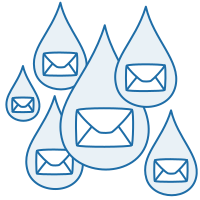In the realm of digital marketing, the subtlety of drip marketing holds a special place. Often described as ‘gentle persuasion’, this strategy is about nurturing prospects with a series of targeted, automated messages. It's akin to a farmer tending to crops with consistent, careful watering - each email is a drop that nurtures the relationship, gradually leading to growth. This article explores how mastering the art of drip marketing can transform your engagement strategy, providing a steady path to conversion and customer loyalty.
1. Understanding Drip Marketing
At its core, drip marketing is a strategic, systematic approach to keeping your audience engaged over time. It involves sending automated, pre-written emails to prospects and customers based on specific triggers or schedules. The objective is not to overwhelm but to provide timely, relevant information that aligns with the recipient's stage in the customer journey.
2. Crafting a Successful Drip Campaign
The key to a successful drip campaign lies in understanding your audience and their needs. Start by segmenting your email list into different groups based on their behaviors, interests, or stage in the sales funnel. Tailor your content to address the specific concerns or interests of each segment, ensuring that each message resonates and adds value.
3. The Power of Personalization
Personalization is a cornerstone of effective drip marketing. Go beyond using the recipient’s name; tailor your messages based on their past interactions, preferences, and behaviors. This level of personalization makes each communication feel more like a conversation rather than a broadcast, increasing the likelihood of engagement and response.
4. Timing and Frequency: Striking the Right Balance
In drip marketing, timing and frequency are crucial. Your emails should be frequent enough to stay top of mind, but not so frequent that they become intrusive. Use analytics to determine the best times to send emails and to understand how often your audience wants to hear from you.
5. Creating Compelling Content
Each email in your drip campaign should be crafted with care. Whether it’s an informative article, a helpful tip, or a special offer, the content should provide tangible value to the recipient. Engaging, well-written emails strengthen the relationship with each ‘drip’, gradually building trust and interest.
6. Leveraging Automation for Efficiency
Automation makes drip marketing manageable and effective. Automated tools allow you to set up triggers based on user actions (like signing up for a newsletter or making a purchase) to send relevant emails at the perfect time. This ensures a consistent and timely flow of communication, essential for maintaining engagement.
7. Measuring and Adapting Your Strategy
Continuously measure the effectiveness of your drip campaigns. Monitor open rates, click-through rates, conversion rates, and other key metrics. Use these insights to refine your approach, adjusting content, timing, and frequency to better meet the needs of your audience.
8. Nurturing Long-Term Relationships
The ultimate goal of drip marketing is to foster long-term relationships with your audience. Consistent, relevant communication not only leads to conversions but also builds a loyal customer base. By continually providing value, you can turn casual prospects into dedicated advocates for your brand.
Conclusion
Drip marketing is an art that requires patience, precision, and a deep understanding of your audience. By mastering this gentle art of persuasion, you can effectively nurture your prospects, guiding them through the sales funnel with a series of thoughtful, targeted communications. This approach not only enhances customer engagement but also solidifies your brand’s presence in the competitive digital landscape, one drip at a time.



